
Lake Oroville, the second-largest state reservoir in Northern California, experienced low water levels during drought. (Photo: California Department of Water Resources)
Depleted California Reservoirs Threaten Hydro Power, Agriculture, Drinking Water
Of the 2014 voter-approved water bond, $2.7 billion for new water storage projects still unused
By Katy Grimes, August 16, 2021 1:15 pm
In 2014, California voters approved $7.12 billion in bonds for state water supply infrastructure projects. Of that, $2.7 billion was designated for water storage projects. But nearly 8 years later, there are no new dams or reservoirs, or other water storage projects to collect and store California’s winter runoff. And California is in yet another drought.
As California Rep. Tom McClintock has said for years, “Droughts are naturally occurring, water shortages are man-made.” He also has warned for many years, “We live in one of the most water-rich regions of the country – yet we have not built a major reservoir in this state since 1979. Meanwhile, the population has nearly doubled. The sad, simple fact is that we will NEVER solve our water problems until we start building new dams once again.”
Recently, Congressman Doug LaMalfa (R-Richvale), State Senator Jim Nielsen (R-Gerber), and Assemblyman James Gallagher (R-Marysville) met at the top of the Oroville Dam to decry Governor Gavin Newsom’s “lack of leadership and gross mismanagement of the state’s water, power and forests/wildlands.” They demanded urgent action because Californians are suffering, and it’s about to get worse they warned.
The state uses about 47.5 percent of its developed water supply for the environment, including wild river flows, managed wetlands and wildlife preserves, habitat and water quality control for fish, and required Delta outflows, according to the Department of Water Resource. Water is diverted in times of drought and times of plenty to the Sacramento-San Joaquin Delta, leaving much less for irrigation or for Californians to drink.
The state has been letting water out of reservoirs across California for months now. And it’s not going to farmers, growers, ranchers or urban use. Environmental policy says the water “flows” from reservoirs are necessary to produce a rebound of endangered Delta smelt and Chinook salmon. However, these policies are a failure as neither species have been collected in all of the latest trawling surveys.
Sen. Nielsen, who is also a farmer and rancher, on Friday denounced the shutdown of the Hyatt Power Plant at Oroville Dam. And California’s other reservoirs are also dangerously draining.
“Governor Newsom and the Democrats running this state should be ashamed,” Nielsen said. “Rather than planning for the future, they kowtowed to environmental special interest groups and stalled the construction of Sites Reservoir.”
Only two years ago, every reservoir in the state was brimming with enough water to last a minimum of five dry years without another drop of rain. Shasta and Oroville reservoirs/dams held enough water to meet the needs of 80 million people for a year.
The Water Quality, Supply, and Infrastructure Improvement Act of 2014, voted on as Proposition 1, authorized the $7.12 billion in general obligation bonds for state water supply infrastructure projects: public water system improvements, surface and groundwater storage, drinking water protection, water recycling and advanced water treatment technology, water supply management and conveyance, wastewater treatment, drought relief, emergency water supplies, and ecosystem and watershed protection and restoration.
Of the $7.12 billion, $2.7 billion dollars was specifically designated for new water storage projects, but thus far, hasn’t been used. “The California Water Commission, through the Water Storage Investment Program is responsible for administering those funds. Only projects that improve the operation of the state’s water system, are cost effective, and provide a net improvement in ecosystem and water quality conditions in the Sacramento-San Joaquin Delta are eligible for Water Storage Investment Program funding,” the California Department of Fish and Wildlife explains.
Fish and Wildlife was charged with identifying “ecosystem priorities and relative environmental values of ecosystem benefits,” defined as: water quality improvements, flood control benefits, emergency response, recreational opportunities, and ecosystem benefits. “At least 50 percent of the total public benefits funded for a project must provide ecosystem improvements,” Fish and Wildlife says, showing their hand.
As the California Department of Water Resources bond oversight shows, no water storage has been added, but ecosystem and watershed protection and restoration projects have been completed:
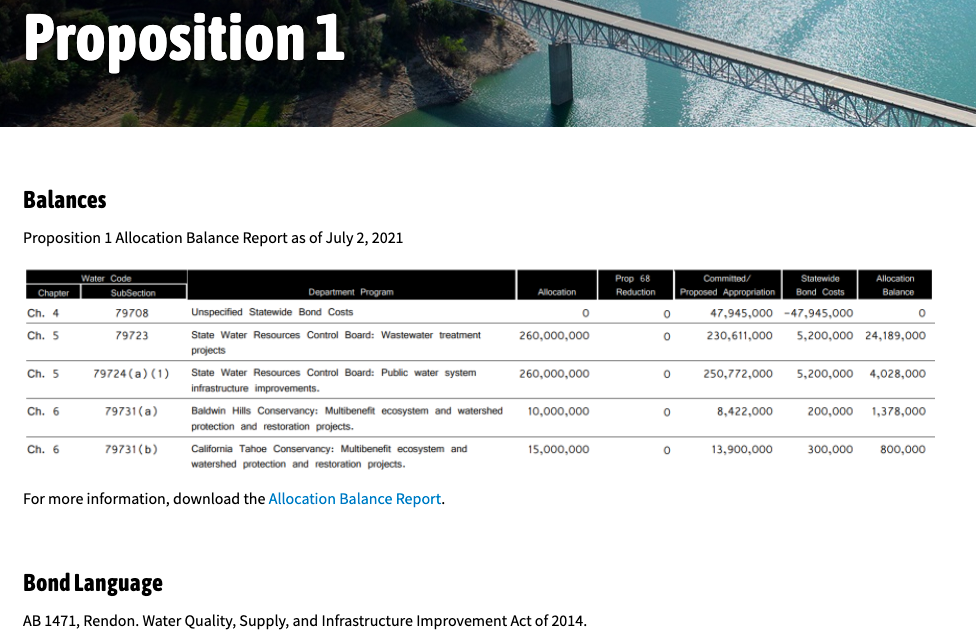
Sen. Nielsen said he was deeply involved in the 2014 water bond package. “We can’t share scarcity,” he said in a Globe interview Monday. “I worked so hard to get people to understand ‘water is critical for for our future, and we did not have enough,'” Nielsen said. “The Delta is only part of California’s water. I told them that East, West, North and South of the Delta also had water issues and scarcity. Even coastal legislators recognize this now.”
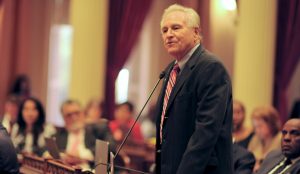
Sen. Nielsen also said he worked very hard to get “Humans have a human right to water” in the water bond statute. “But this administration is ignoring this,” Nielsen added.
Sen. Nielsen explained, “When there’s adequate water in Lake Oroville, Hyatt (hydroplant) can generate up to 900 megawatts of electricity. Typically, it produces 450 megawatts – enough to power 800,000 homes. However, due to the record low water levels, only 10 megawatts of electricity were being generated, which is why the decision was made to take it offline.”
As for energy, Nielsen said the Biden administration has added to California’s energy woes by further dismantling the natural gas pipeline and calling for the end to natural gas production in the U.S. “Wind and solar never suffice… we’re in trouble,” he added.
Because so much of Sen. Nielsen’s district is on fire, he is gravely concerned where the water to fight fires will come from. “The super scoopers used by pilots – it may be too dangerous” (to attempt to scoop water from certain reservoirs)… “they are too low,” he added.
Today we see that the San Luis Reservoir is dangerously low:
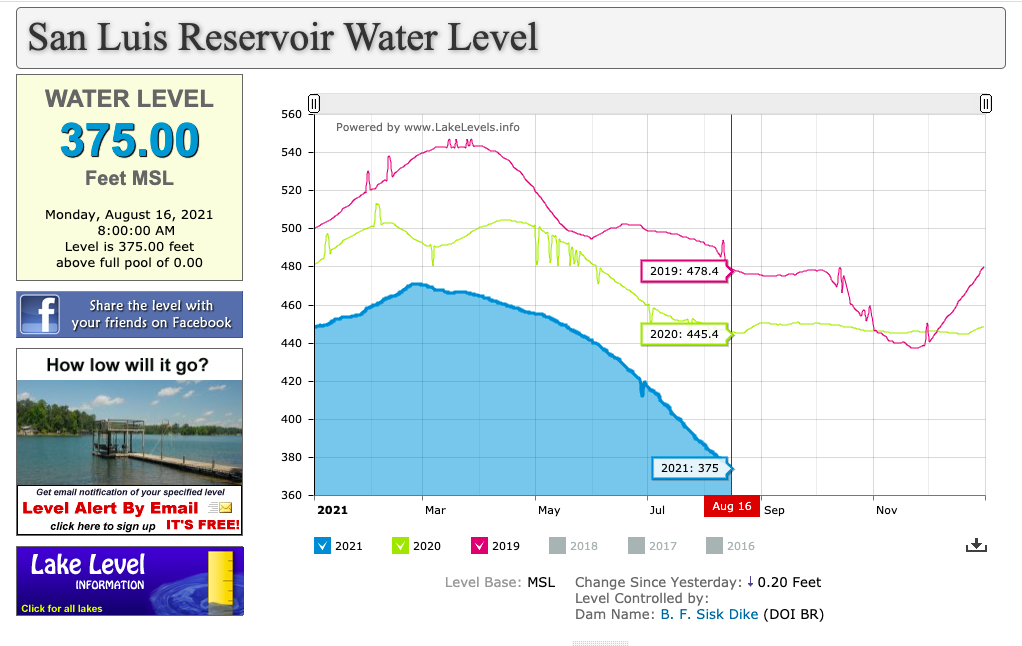
“In April, California Gov. Gavin Newsom held a press event in Oroville, with a 60% empty Oroville Dam Reservoir as his backdrop, and said he was not ready to declare an official drought emergency – despite that the previous two weeks 91% of Delta inflow went to the sea, state pumps were at -97%, federal pumps at -85%, and outflows showed 6,060,828,600 gallons. Since April, Oroville has been drained almost dry,” the Globe recently reported.
As for Lake Shasta Reservoir, in June 2019 Shasta held 4.4 million acre feet of water in storage. An acre foot of water is enough to supply 10 people for a year, said Central Valley farmer and water expert Kristi Diener, who runs the California Water For Food and People movement.

And here are the Shasta water levels as of Sunday:

Sen. Nielsen said with so many in his communities needing water to be trucked in because of the wildfires, there have been no truck drivers to truck the water in, and several gas stations even ran out of fuel. “Where will the water come from?” Nielsen asked.
Sen. Nielsen said in his West Counties and Yolo County North, domestic wells are drying up. And with agriculture wells also drying up, “you lose your crop.” Nielsen said even if farmers can get someone to agree to come out and drill the ag well, they are booked well into October.
“I’m very concerned this drought will last into next year,” Sen. Nielsen said.

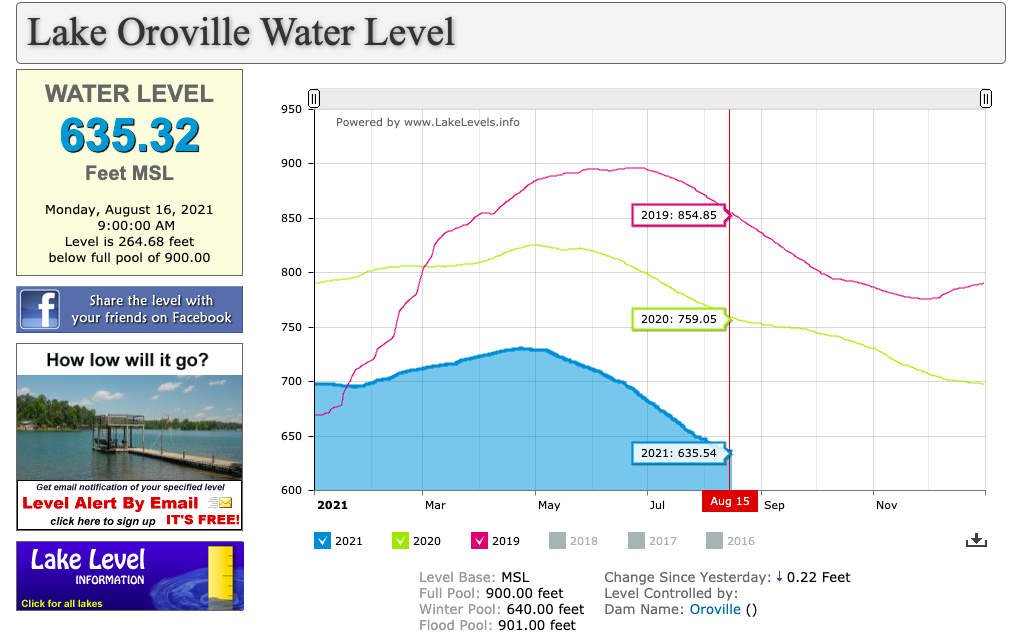

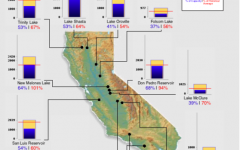
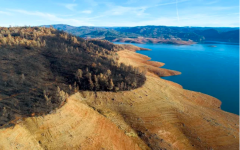
If the recall election is successful in removing Newsom the new Governor has to stand up against the environmentalists and their movement. They have been in control of this state for far too long. If anyone is interested a good book on this radical movement is “Eco Tyranny” by Brian Sussman. It was first published in 2012 but it is so spot on to what is happening today.
John The Patriot – Hey, thanks for the tip. Another is “Green Hell” by Steve Milloy who runs the JunkScience.com blog.
Comrades
Oh Oh. More fear…..you’re worked daily, unrelenting…..
Doing my rain dance, Queeg. I wonder what ever happened to cloud seeding.
Why???
Because we have mostly DUMBASSES in Sacramento!!!
Fire Newsom first, then start recalling most of the San Franfreakshow legislators, then metro El Lay, then San Diego….
Reevaluate, rinse and repeat…
“Of the $7.12 billion, $2.7 billion dollars was specifically designated for new water storage projects, but thus far, hasn’t been used”…
THIS FAILURE ALONE IS GROUNDS TO CALL FOR RESIGNATIONS!
And don’t even get me started on Diablo Canyon, and the “magic bullet train to nowhere”
WHAT A LOAD OF BS. “Only two years ago, every reservoir in the state was brimming with enough water to last a minimum of five dry years without another drop of rain. Shasta and Oroville reservoirs/dams held enough water to meet the needs of 80 million people for a year.” Really? Shasta and Oroville hold a total of 8 million acre feet. SWP signed contracts for 4 MAF per year, the CVP for 7 MAF per year. How does 8 MAF last 5 years when Delta farmers use 2 MAF per year (and they have senior water rights and are getting all their water every year, including this one) and it takes 3.5 to 4 MAF per year to keep the Delta fresh enough to send water south??? Explain that!!
We have an unlimited supply of water. It’s called the Pacific Ocean. Where are the desalinization plants? Oh, that’s right. The environmentalists and Democrats are blocking them. Why? Because the left uses shortages and rationing as a tool to control people, and get their money. It has nothing to do with the environment. Desalinization plants can run on solar power, and the salt can be disbursed back into the sea where it came from. For some reason, these same Democrats and environmentalists have no problem with Los Angeles dumping sewage sludge into the ocean from the Hyperion Sewage Treatment Plant.
Why hasn’t Newsom declared a water emergency and rationing? The recall. If he survives the recall, there will be rationing within a week. Mark my words.
A more practical use of the extracted salt from desalination plants (instead of dumping it) would be to manufacture sodium metal – used in cooling modern nuclear reactors. So, desalination can produce a useful byproduct as well as potable water.
Absolutely! Especially for the simple reason that we use nuclear energy produced for numerous reasons and the viable use of desalination is not only resolved for that use but the end result of potable water is a definite problem for us that we need to resolve. The way we have misused Mother Nature and stripped our Planet by overpopulation of human beings it’s amazing we have ANY water at all!
Because the Chinese want the farmland, cheap…
As long as the smelt are safe, that’s the main thing (to anarchists).